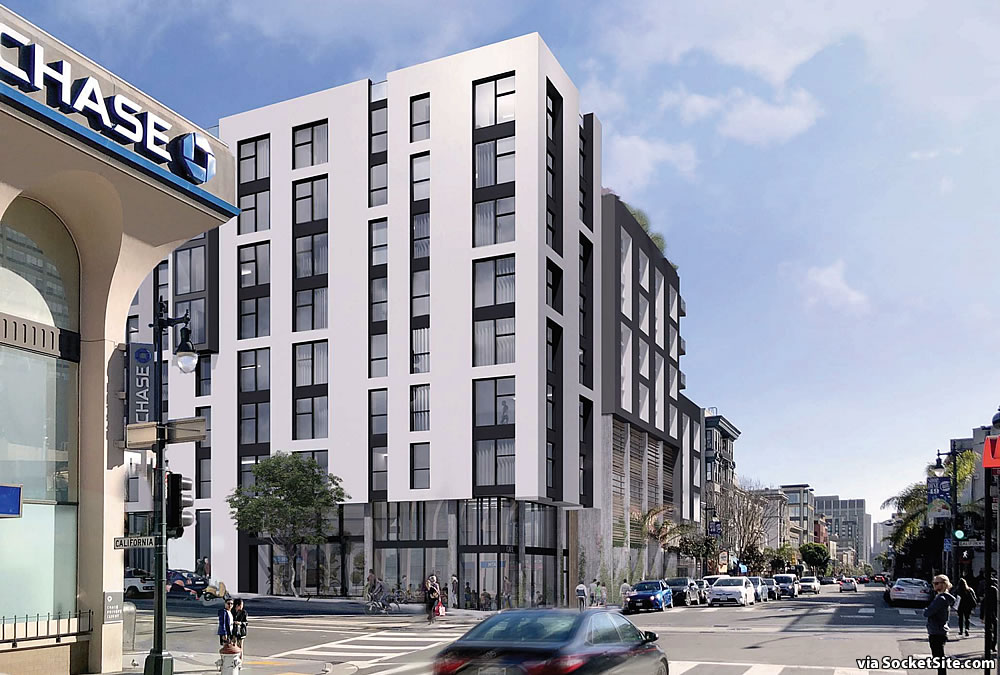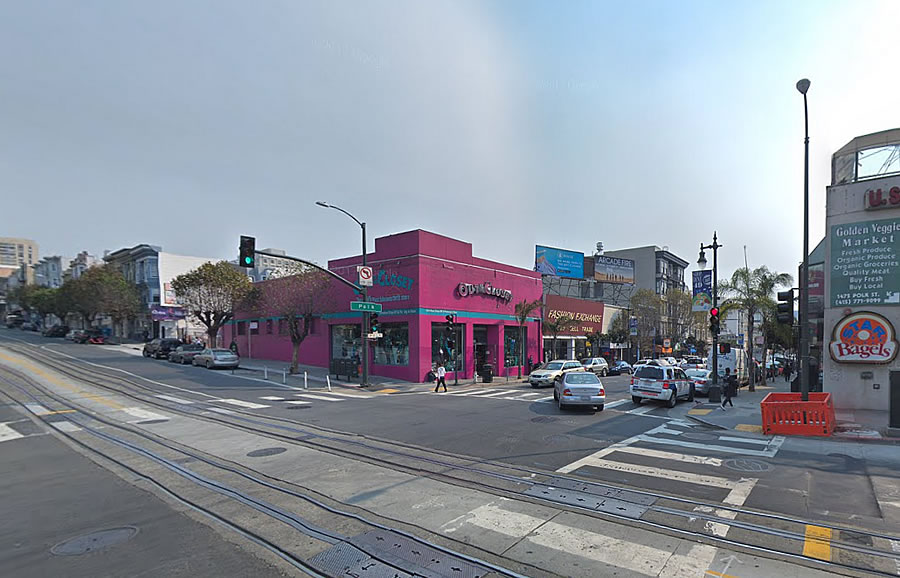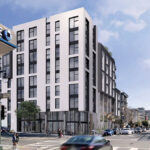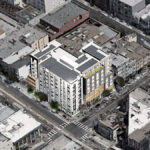Having been entitled by Planning last year, the plans for an 8-story building to rise up to 80 feet in height on the Out of the Closet site on the southeast corner of Polk and California have been slightly refined to yield 97 units, versus 100 as approved, but with five (5) more one-bedrooms, for a total of 34, and seven (7) fewer studios for a total of 13 and the remainder a mix of two and three bedroom units (along with nearly 10,000 square feet of new ground floor retail space and a storage room for bikes)
And while demolition permits have yet to be issued, the building permit for the bonus-sized Polk Gulch project development, which had been on hold, is now close to being issued by the City as requested by the project team.




Bold & beautiful addition to underutilized site and ray of hope for in resilient city of SF
When you say “bold and beautiful” I think you meant “copy/paste from 100 other developer driven housing projects with no vision or soul.”
When you say “underutilized” I think you meant “last of the almost affordable retail sites for underserved communities”.
When you say “resilient” I think you meant “woefully vulnerable infrastructure of San Francisco.”
I’ll bet the people in 1907 also complained about all the uninspired, copy/paste Victorians going up everywhere, nearly indistinguishable from each other.
I don’t have a problem with architecture being “of its time.” Yes, all the stuff built in the last ten years looks like all the other stuff built in the last ten years. Twenty or thirty years from now, new stuff will probably look different than today’s.
What would you prefer, faux-Victorians? Brutalist? Those ugly boxes from the 60s?
Well they wouldn’t actually be Victorians in 1907…
But anyway, I don’t think L’Urb was complaining: s/he was simply offering a translation of Clichese>English…one which, by your acknowledgment that such “bold(ness)” is going up everywhere, you seem to agree with.
I just thank Zeus there are no orange, yellow, red or green panel surfaces in the design……
What you mean yet again is “I personally dislike it, therefore it’s bad.” Disingenuously using buzzwords to try and mask that doesn’t change the underlying meaning.
This thread is so indicative of why a robust planning apparatus (as opposed to the co-opted rubber stampers we have in place now) is so important for the vitality of cities. Commenters here are developer-schills, for whom the aesthetic of a dollar Trumps all other notions of aesthetics. Its so easy to imagine them in the 60’s touting the gorgeous apartments being built on Twin Peaks. Its laughable and yet tragic how our city continues to allow one after another truly hideous computer-generated building get slapped up. Buildings that are identical (often including their naming, like NEMA – because the same mega-developers are responsible) to ones in dreary suburbs across the country. Why are we paying a staff to supposedly guide the city’s user experience if the only user experience they are guiding is leading developers to an ATM? These people plainly have so little respect for the city – i’m sure they also hate most of the forces that made SF amazing in the 1st place.
This building looks nothing like NEMA.
To be clear, it seems like the built structure of the city you admire is from before the days of planning departments and design review, and the structure you denigrate (Twin Peaks) was built with those “safeguards” in place. Given that, what would you say made San Francisco “amazing in the 1st place”?
@Jake T
Could not agree more. One of the most uninternationally funny books I ever read was the Geography Of Nowhere by James Kunstler . A typical screed against “suburbia”.
What the book actually provided was overwhelming evidence for fact that all the places people actually wanted to live in, and loved to live in, where places that were built before the rise of professional urban planners in the post war era. The author loved urban planning, he really like the urban planners he talked to, yet in case after case urban planners created one urban disaster after another. All the most livable places evolved organically, without urban planners, all the unlivable urban spaces are the direct result of grand theories of urban planners.
Typically, the one hugely successful example of “urban planning” in the last century, the “Garden Suburb” movement, is universally derided by urban planners. For daring to create places ordinary people would like to live in.
What the last century has proved is that urban planning is completely incompatible with creating or sustaining cities that are actually pleasant to live in. For the long term residents. So fire all urban planners, just enforce basic structural safety codes, and watch the City very quickly improve in a decade or two.
What do you think made SF amazing? Most of the city’s iconic buildings were not subject to the level of design review required today, and many would no long be approved because they do not conform to existing zoning.
comments like above are indicative of cluelessness of the many many many constraints of getting annything built. its hilarious actually. perhaps a 1st / 2nd year architecture student? almost not worth a response.
Happy to see this project, and happy to have it displace the Out of the Closet store, which benefits an evil organization that purports to help people with HIV but which is actually dedicated to perpetuating the disease and enriching its billionaire owner.
Pretty sure AHF owns/owned the building and is the primary financial benefactor of the new development.
Not sure how much light those solar panels will get in the late afternoon when the sun sets behind the Holiday Inn
I don’t think you know how solar panels work.
Welp, haven’t heard that one before. Care to share how free HIV testing is evil?
Conflicted – I’ll miss Out of the Closet, though I frequented their Folsom location more anyway. They’re opening a location in San Diego to replace it at least.
I continue to be skeptical that any of these recently announced/permitted projects will move forward in the foreseeable future. Everyone seems to think that developers have these huge margins where they are automatically raking in the money, rolling around in gold coins like Scrooge McDuck. The reality is much closer to projecting out 2-3 years rents (and future increases in rents) and then assuming a tight interest rate environment that would support a 5%(+/-?) return on the cost of building.
In the past year, the rental market has dropped by 25%. The future income from the project drops dramatically.
Six story wood-framed buildings are about the most cost-effective way of building urban housing that we have at present. Yet since the pandemic, prices of inputs (wood an obvious one) have nearly doubled.
For an investment project already teetering on a long lever of low returns, when you dramatically increase the costs and lower the projected revenues, they stop ‘pencilling’ out. In other words, building a new structure looks like an exercise in losing money instead of making money. Banks won’t make construction loans on these deals.
The only projects I expect to see in the next 36 months will be public money and/or dumb money, where politicians can still claim victory and tax dollars have no master except political careers and favors. Not to be negative, but this isn’t a good time to build in San Francisco.
On the flip side, if you are the only market rate builder moving forward it could be a great time to start.
You mean like how it was a great time to be a small burrowing mammal right after that asteroid wiped out the dinosaurs? Even that took a few years to ‘pencil out’ as a win.
The pace of evolution is faster than San Francisco permitting, but otherwise a good comparison.
Regarding this particular project, this is the most rapidly it has moved forward in fifteen years. The owners have held this land for a long time and have been in planning forever, but they reorganized their ownership into an LLC just a few months ago and it looks like planning will complete. So their perspective on the economics must be different from yours. Specifically since their land cost is zero (or sunk, if you like).
I don’t know the specifics of the site and rationale for ownership, but f the choice is (made-up numbers):
A: Sell the site for $4-5mm
B. Spend $35mm to construct a building worth $28mm
and you choose, B, you’ve met my definition of ‘dumb money.’
The ‘fallacy of sunk costs’ is a widely recognized human foible in investment psychology.
Let us all stop to appreciate how this plan has improved since it was initially proposed in 2007. Back then they wanted to build 47 apartments with 89 parking spaces. Now they want 97 apartments and zero parking spaces. That’s progress.
The city could’ve removed parking minimums long ago. The same lack of vision which causes it to take 13 years for a project to break ground also perpetuates really miserable urban policy like our joke of a transit system and appalling land use.
It would be so cool to be able to ride a cable car to and from work downtown.
On the flip side, it kinda sucks living directly on the cable car line. Those things are loud and run fairly late into the night. In this building, I’d want a unit as far from California St as possible.
It would be cool to commute on a cable car if one likes moving at pedestrian speeds, getting dry-humped by bleary tourists. Granted, that’s why some people move to this city.
Pay $8 to ride nothing more than a tourist attraction. I’d rather take the 1 and get there in half the time. For less than half the price.
I was on a cable car once. Back when Regan was president. It was around 7am at Beach and Hyde on weekday and the car was empty so I thought – what the hell – took it downtown. Not impressed. Even as a tourist attraction. So once in 35 years is more than enough.
If I want a thrilling transportation experience in SF where I get to see and hear (and smell) the passing city streets I’ll just drive with my car windows rolled down. And with the current state of the streets it will be just as jarring and unconformable as the cable car.
The California Street cable car is unknown to tourists and is pretty practical. A monthly pass, which every SF resident needs anyway, makes the marginal cost of riding the cable car zero.
So spend $81 a month for “free” cable car? To take 3 times as long as a bus to get anywhere. Interesting definition of free.
As for “needing” a Clipper Card most people in SF have survived quite nicely without FastPasses / Clipper cards in the decades I have lived here. MUNI accounting for less than 20% of all journeys and less than 10% of all passenger miles in the City. Numbers which have not changed that much for decades. Which is not surprising given how truly awful the MUNI experience is. And yes I have been a semi regular MUNI user since the mid 1980’s, have a very old battered Clipper Card, and know how to get anywhere in the City on the (pre Covid) routes. So I know of what I speak.
SF was always a car city and always will be a car city. If you want to get anywhere in a reasonable timeframe and without great discomfort. Those of you who know your municipal history will know why SF will never ever have functional, efficient, cost effective public transit. The history of the original streets-cars and how the unions (with a lot of help from City Government) killed them being a great case study.
Yep! I took the cable car most days from California/Larkin over the hill to FiDi and back at night. It was almost never full, unless it was raining and everyone tried to cram into the center area. Other than that, relaxing and a fantastic way to commute. Bollocks to the person saying to commute on the crazy packed 1. Cable car over 1 Sacramento any day.
UPDATE: Fully-Approved Polk Street Project Put Up for Sale, not positioning to break ground.